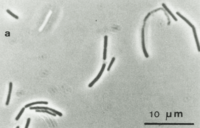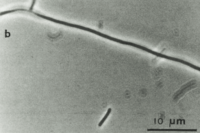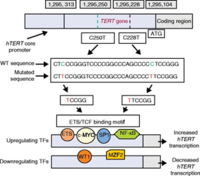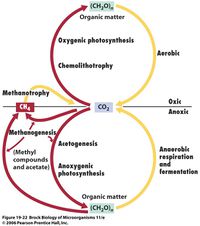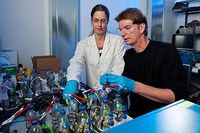Methanobacterium palustre: Difference between revisions
| Line 27: | Line 27: | ||
Optimal pH for growth is approximately 7 and a pH value as low as 6 is known to be tolerable. | Optimal pH for growth is approximately 7 and a pH value as low as 6 is known to be tolerable. | ||
The microbe is sensitive to salinity. Growth is impeded at 18 g/L NaCl and growth completely halts at 30 g/L NaCl. | The microbe is sensitive to salinity. Growth is impeded at 18 g/L NaCl and growth completely halts at 30 g/L NaCl. | ||
When focusing on ''Methanobacterium palustre'''s metabolism, it is an autrophic microorganism that undergoes methanogenesis. In order to utilize this process, the conditions must be anoxic. This means that ''M. palustre'' is anaerobic and found at low depths within its peat bog environment. The microorganism's metabolism is dictated via 2 processes: the Carbon Cycle and Alcohol Dehydrogenase enzyme. When following the Carbon Cycle pathway, carbon dioxide oxidizes hydrogen gas to produce methane and water. In this case, hydrogen gas is the electron donor and carbon dioxide is the electron acceptor. The alternate pathway, as stated above, utilizes an alcohol dehydrogenase enzyme to convert carbon dioxide and 2-propanol. This reaction produces the products methane and acetone. In this case, the hydrogens bound in the 2-propanol molecule are the electron donors and carbon dioxide is the electron acceptor. | |||
==Significance in Today's World== | ==Significance in Today's World== | ||
Revision as of 16:07, 21 April 2014
Classification
Domain: Archaea--- Kingdom: Euryarchaeota--- Phylum: Euryarchaeota--- Class: Methanobacteria--- Order: Methanobacteriales--- Family: Methanobacteriaceae--- Genus: Methanobacterium--- Species: Palustre
Species
|
NCBI: Taxonomy |
Methanobacterium palustre
Description and Discovery
Methanobacterium palustre was discovered in 1989 in a location in Germany known as the Sippenauer Moor. The environmental habitat dominating in this area is known as a peat bog. Others often refer to it as a marshland. Due to its ability to anaerobically produce methane through a process known as methanogenesis, researchers thus named it's genus "Methanobacterium". Ironically the term used for the species identification, "palustre", is French for the word: marshland. Therefore the microorganism could be described as an Archaea that thrives in a marshland habitat via producing methane metabolically. (Zellner, G., et al.)
Cell Morphology
Methanobacterium palustre has a thin, rod-like shape and has been characterized as Strain F. This bacillus microorganism has an average cell length of anywhere between 2.5µm – 5µm. The cell body occasionally has filamentous appendages protruding outwards. These are used mostly as a means for cellular reproduction. In comparison, the appendages are over 10x the length of the actual cell body measuring to about 65µm. A Gram stain revealed that it is in fact Gram Positive meaning that it lacks a peptidoglycan layer outside of its cytoplasmic membrane. After viewing this microorganism using the wet mount technique, motility was not observed. Therefore, M. palustre must rely on water currents to move about its anoxic environment. (Zellner, G., et al.)
Ideal Living Requirements and Metabolism
Methanobacterium palustre is a mesophilic organism, best suited for temperatures between 33 degrees and 37 degrees Celsius. The minimum and maximum growth temperatures are between 20 degrees and 45 degrees, respectively. Optimal pH for growth is approximately 7 and a pH value as low as 6 is known to be tolerable. The microbe is sensitive to salinity. Growth is impeded at 18 g/L NaCl and growth completely halts at 30 g/L NaCl.
When focusing on Methanobacterium palustre's metabolism, it is an autrophic microorganism that undergoes methanogenesis. In order to utilize this process, the conditions must be anoxic. This means that M. palustre is anaerobic and found at low depths within its peat bog environment. The microorganism's metabolism is dictated via 2 processes: the Carbon Cycle and Alcohol Dehydrogenase enzyme. When following the Carbon Cycle pathway, carbon dioxide oxidizes hydrogen gas to produce methane and water. In this case, hydrogen gas is the electron donor and carbon dioxide is the electron acceptor. The alternate pathway, as stated above, utilizes an alcohol dehydrogenase enzyme to convert carbon dioxide and 2-propanol. This reaction produces the products methane and acetone. In this case, the hydrogens bound in the 2-propanol molecule are the electron donors and carbon dioxide is the electron acceptor.
Significance in Today's World
Methane is known to be a major greenhouse gas, over 25 times more potent than carbon dioxide. Although the exact impact of M. palustre is unknown, wetland microbes alone emit 164 teragrams of CH4 per year.
M. palustre also has potential for use in microbial fuel cells. Researchers at Stanford University and Penn State University have developed advanced cathodes that fuel the microbes' metabolism with the use of electricity. The resulting methane is captured then combusted as fuel. If the electricity used to power the reaction was obtained by emissions free sources, then the net carbon output is zero. The carbon released by the combustion of the methane originally came from atmospheric carbon dioxide. (Schwartz, M)
References
Zellner, G., et al. Chracterization of a New Mesophilic, Secondary alcohol-utilizing methanogen, Methanobacterium palustre Spec. Nov. from a Peat Bog. Archives of Microbiology, Springer-Verlag: 151-160.
Zellner, G., et al. Methanobacterium palustre picture 1. 1989. pdf.
Zellner, G., et al. Methanobacterium palustre picture 2. 1989. pdf.
Schwartz, M. "Stanford scientists use microbes to make 'clean' methane". Stanford Report, July 24, 2012.
Schwartz, M. "Stanford scientist research picture. 2012. jpg.
Author
Page authored by Brian Underwood and Joe Wernet, students of Professors: Ned Walker and Kaz Kashefi at Michigan State University.
